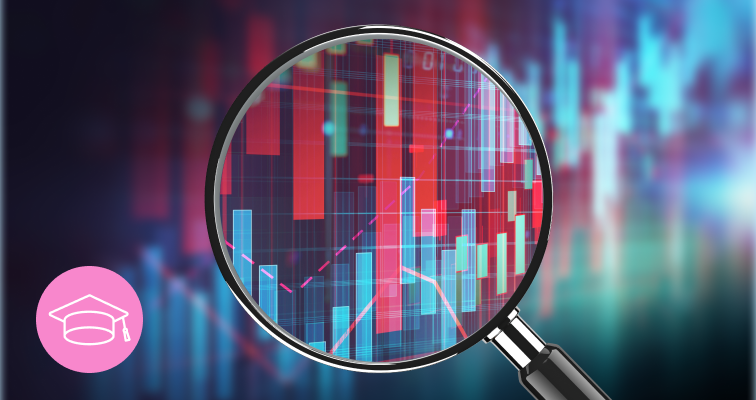Technical analysis is used to develop trading strategies based on market data such as trade volumes rather than higher level macroeconomic events. Learn what technical analysis is, how it can be used by traders and investors, and how it compares to fundamental analysis.
Technical analysis is a data-driven approach that traders use to analyse the financial markets and try and identify trading opportunities. Technical analysis looks at historical market events to try and predict future price moves, and it can be used on its own or in conjunction with other trading strategies.
One of the biggest selling points of technical analysis is that it provides indicators that investors can use to determine when to buy or sell in any market.
What is technical analysis?
Technical analysis is a form of analysis that uses historical data to predict the probability of a future price move. Price data forms the core of technical analysis, but the approach can also incorporate trade volumes and other metrics.

The approach can involve applying statistical formulae and utilising tools such as oscillators and stochastics. Alternatively, it can involve adopting a charting approach and noticing patterns on a price chart.
Online brokers provide investors with powerful software tools that analyse statistics on their behalf. From the perspective of an investor or trader, technical analysis involves accessing a price chart and establishing which indicator gives the best signal.
Why is technical analysis used by traders and investors?
Technical analysis can help to generate clues about the levels at which price might bounce off a support level or break through resistance.
Tracking those levels can allow traders to establish whether a market is ranging or trending, and understanding the underlying conditions of any market is a crucial part of the trading process.

Where can you use technical analysis in investing?
Technical analysis can be applied to any asset class. It can also be used over any timeframe, in both short- and long-term strategies, although longer timeframes are generally considered to be better.
Tip: Once you understand the basics of technical analysis, you can apply it to any market you want to trade.
Technical analysis in stocks
Technical analysis can be used to trade stocks, particularly in the short term. For example, day traders might buy and sell stocks to take advantage of short-term pricing anomalies that are identified using technical analysis.
That being said, a large amount of stock market activity is still made up by investors and analysts who use fundamental analysis and valuation models to determine whether a stock is over or undervalued.
Technical analysis in forex
Over the longer term, currency prices are largely determined by macroeconomic factors and geopolitical events. During the periods when news events are not driving price moves, forex technical analysis can help you to spot shorter term trading opportunities.
Tip: Over the long-term, forex markets do not have an upward directional bias in the same way that stocks do.
Technical analysis in CFDs
CFD trading allows investors to sell short, as well as go long. This means that CFDs could be an ideal fit for technical analysis, which can identify opportunities to both buy and sell assets.
Tip: CFD trading can utilise short-selling and trading with leverage, but CFD positions will incur overnight financing fees.
Technical analysis in crypto
Technical analysis is a useful tool for those trading the cryptocurrency markets, as it incorporates volatility metrics that can offer an indication that the next big move is about to occur.
At the same time, trendlines and moving averages can offer a way to plot the course of coins or tokens and highlight the levels at which price moves will meet support and resistance.
Technical analysis vs fundamental analysis
Fundamental analysis is an alternative method of identifying and managing trades. It uses “real-world” information, such as company reports and news updates, to establish the fair value of an asset. On the other hand, technical analysis focuses on data and chart patterns to predict future price moves.
Tip: Many traders are naturally drawn to either technical or fundamental analysis, but it is possible to use both simultaneously.
There are lots of differences between technical and fundamental analysis:
| Fundamental Analysis | Technical Analysis | |
|---|---|---|
| Used By | Investors | Traders |
| Time Horizon | Medium- and long-term | Short-term |
| Data Source | Economic reports, news events and industry statistics | Chart analysis and price data |
| Good For | Determining if an asset is priced appropriately | Price entry and exit points and for establishing market conditions |
Pros & cons of technical analysis
Both fundamental and technical analysis have positives and negatives. Combining both approaches into your analysis can balance things out. Below, you can see the advantages and disadvantages of fundamental analysis and technical analysis.
Fundamental analysis
- Forward and backward looking
- Builds a bigger picture
- Can spot trends before they happen
- Research can be more time- intensive
- Relies on all important information being publicly available
- It can be difficult to be objective
Technical analysis
- Indicates times to sell and buy
- Useful for risk management and measuring sentiment, and instils discipline into strategies
- Self-fulfilling — many traders will be using the same signals
- Trading strategies can be automated
- Only looks backwards
- Doesn’t factor in new fundamental price drivers
- Different indicators can give opposing signals at the same time
- False signals can occur

Final thoughts
Technical analysis in its simplest form can involve spotting a trend on a price chart and working on the premise that unless there is a catalyst for change, price will continue to move in the direction that it is already heading.
That approach can work, but there is more to technical analysis than that. There are hundreds of different indicators to choose from, each one offering a different insight into market conditions, and helping you to trade and manage risk more effectively.
Visit the eToro Academy to learn more about technical and fundamental analysis.
Quiz
FAQs
- How can I use technical analysis to manage risk?
-
Technical analysis can help you to adopt a more disciplined approach and avoid emotional investing. Having predetermined price levels at which you expect to open and close positions can reduce the risk of one bad trade wiping out your account. Stop-loss and take profit orders can also be utilised to ensure that losses are mitigated and profits are booked in automatically.
- Should I use technical or fundamental analysis?
-
Usually, experienced investors will use technical and fundamental analysis in combination. However, it is possible to give greater weight to one over the other, but that will depend on your personal approach which will also likely change over time.
- How much trading activity is based on technical analysis?
-
This varies from asset to asset. Taking the stock market as an example, JP Morgan estimates that more than 20% of US stocks are owned by “quant” funds, which base their approach solely on technical analysis. The remaining 80% are also likely to use technical analysis to some degree.
This information is for educational purposes only and should not be taken as investment advice, personal recommendation, or an offer of, or solicitation to, buy or sell any financial instruments.
This material has been prepared without regard to any particular investment objectives or financial situation and has not been prepared in accordance with the legal and regulatory requirements to promote independent research. Not all of the financial instruments and services referred to are offered by eToro and any references to past performance of a financial instrument, index, or a packaged investment product are not, and should not be taken as, a reliable indicator of future results.
eToro makes no representation and assumes no liability as to the accuracy or completeness of the content of this guide. Make sure you understand the risks involved in trading before committing any capital. Never risk more than you are prepared to lose.


